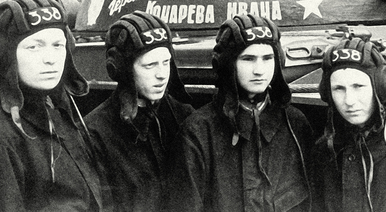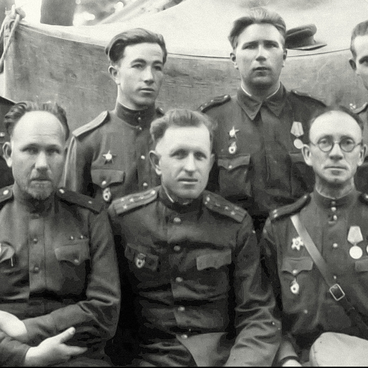Nikolai Vatutin’s photo opens the exhibition of military commanders in the Belgorod axis of the Kursk Bulge. He led the Voronezh Front in 1943. The hereditary peasant was born in 1901 in the village of Chepukhino (now Vatutino) in the Belgorod Region. He started his service in the Red Army as an ordinary soldier and advanced through the ranks up to the General of the Army. After leading the Voronezh Front, he also led the Southwestern Front and the 1st Ukrainian Front up to his death as a result of a gunshot wound from an ambush by a Banderite in 1944.
Near him, there is a photo of another Lieutenant General of peasant origins. This man was Vasily Kryuchenkin, the commander of the 69th army. His units accepted the Battle of Prokhorovka and stood victorious in the largest tank battle of the Second World War. Ivan Chistyakov commanded the 21st Motor Rifle Division, which received the rank of the 6th Guards Motor Rifle Division for gallantry and heroism of its troops in action during battles on the Kursk Bulge. Its soldiers together with tank crewmen of the 1st Tank Army under Mikhail Katukov’s command endured the attacks and artillery fire of the dominant Wehrmacht’s forces for a week. After that, they launched a counteroffensive near Kochetovka and threw the enemy back. The liberation of Belgorod and Kharkov was in front of them.
Mikhail Shumilov commanded the 7th Guards Army which repelled the attacks of the invaders directed from Belgorod to Korocha. The Germans failed to crash into the defence and were thrown back to their starting positions. After that, the 7th Guards Army launched the offensive and participated in the liberation of Belgorod and Kharkov. The next steps on the battle path were the assault crossing of Dnieper and liberating Right-Bank Ukraine from the occupants.
The Voronezh Front was supported by the 2nd Air Army commanded by Stepan Krasovsky, the future marshal of aviation, and the 17th Air Army commanded by Vladimir Sudets. Their pilots won the battle for the skies over the battlefield.
All of the unit commanders of the Voronezh and Steppe Fronts fully showed their captainship talents during the Battle of Kursk. Their fighters stood strong and fought with courage against elite forces of the Wehrmacht and the SS, which were geared up with the Third Reich’s strongest weapons of that time. Look at these simple peasant faces, and you will notice that their eyes are full of dignity and self-confidence. Is there anyone whose examples are more worthy to follow?
Near him, there is a photo of another Lieutenant General of peasant origins. This man was Vasily Kryuchenkin, the commander of the 69th army. His units accepted the Battle of Prokhorovka and stood victorious in the largest tank battle of the Second World War. Ivan Chistyakov commanded the 21st Motor Rifle Division, which received the rank of the 6th Guards Motor Rifle Division for gallantry and heroism of its troops in action during battles on the Kursk Bulge. Its soldiers together with tank crewmen of the 1st Tank Army under Mikhail Katukov’s command endured the attacks and artillery fire of the dominant Wehrmacht’s forces for a week. After that, they launched a counteroffensive near Kochetovka and threw the enemy back. The liberation of Belgorod and Kharkov was in front of them.
Mikhail Shumilov commanded the 7th Guards Army which repelled the attacks of the invaders directed from Belgorod to Korocha. The Germans failed to crash into the defence and were thrown back to their starting positions. After that, the 7th Guards Army launched the offensive and participated in the liberation of Belgorod and Kharkov. The next steps on the battle path were the assault crossing of Dnieper and liberating Right-Bank Ukraine from the occupants.
The Voronezh Front was supported by the 2nd Air Army commanded by Stepan Krasovsky, the future marshal of aviation, and the 17th Air Army commanded by Vladimir Sudets. Their pilots won the battle for the skies over the battlefield.
All of the unit commanders of the Voronezh and Steppe Fronts fully showed their captainship talents during the Battle of Kursk. Their fighters stood strong and fought with courage against elite forces of the Wehrmacht and the SS, which were geared up with the Third Reich’s strongest weapons of that time. Look at these simple peasant faces, and you will notice that their eyes are full of dignity and self-confidence. Is there anyone whose examples are more worthy to follow?



